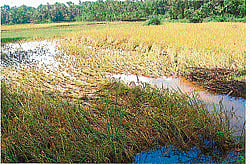
Agriculture in India is the means of livelihood of almost two thirds of the work force in the country. It has always been India’s most important economic sector. Owing to the heavy and untimely rains, majority of the crops get damaged.
Standing paddy crop, arecanut, pepper, coconut, cocoa, cashew have been damaged extensively in Dakshina Kannada district owing to the untimely rain that lashed the district.
Farmers’ hopes of harvesting a good crop this year have been shattered by the rain that lashed. Now, the farmers are worried that the crop loss will push them into debt.
According to a preliminary survey conducted by Vivekananda College Economics department Lecturer Dr Vighneshwara Varmudy, loss due to rains in Dakshina Kannada during 2010 has been put at Rs 500 crore.
Dr Varmudy had conducted a survey on the loss of arecanut due to fruit rot disease in 2007-08 and submitted to the state government. Accordingly, the government had released Rs 13 crore to provide compensation to the growers.
Speaking to City Herald, Dr Varmudy said horticulture crops like arecanut, coconut, cashew, pepper, banana and rubber are grown prominently in the district. Compared to other districts, DK stands top in the production of white arecanut. The district is in the ninth place in the production of coconut. It is also highest producer of cocoa and rubber.
As the district plays a vital role in the agriculture sector of the state, any change in pattern will have an impact on the economy of the entire state, he added. Compared to last year, the loss in crops is more this year. Last year, the region received rain after completing the harvest.
However, this year, standing crops could not be harvested owing to the heavy rains that lashed even after mid-November. As per the available statistics, the area under cultivation increased in 2003-04.
However, there has been deep decrease in the area under cultivation barring cocoa and rubber in the last two years owing to urbanisation, steep fall in the price of agriculture crops, shortage of labourers, increase in the production cost, shortage of irrigation, decrease in the interest in agriculture by the small farmers.
Amidst decrease in the area under cultivation, there has been considerable decrease in the production of paddy, vegetables, arecanut, coconut, cocoa, pepper, cashew, banana owing to the heavy rains that lashed the district between April and November 22. Owing to the untimely rain in November, standing crops could not be harvested thus incurring huge loss to the farmers, he added.
He said for the survey on the loss of crops, he has collected opinions of about 50 farmers each in five taluks of Dakshina Kannada. Small farmers, medium farmers, large farmers were selected randomly to come to a conclusion on the loss of crops.
He says owing to the heavy rains, 60 per cent of arecanut has been lost in Mangalore taluk, 68 per cent in Bantwal, 69 per cent in Puttur, 72 per cent in Sullia and 68 per cent in Belthangady. The total production of white arecanut would have been 49,323 tonne during the period.
Owing to the heavy rain, the arecanut was infected with fruit rot disease between July and September. As a result, the arecanuts started withering.
According to the survey, owing to the heavy rains and mite disease, 50 per cent of coconut crop has been lost in the district.
Owing to the heavy rain, the tender coconuts started withering much early. Moreover, owing to the shortage of labourers, coconuts could not be plucked.
The survey says that cocoa which was recovering in the district has incurred a loss of about 60 per cent in the district owing to the rains.
Even cashew plantation is under threat. As a result, cashew industries have started importing cashew from other countries. Owing to the untimely rains in October and November, cashew trees have not yet started flowering. This will have an impact on the production.
The cashew production is likely to be affected by 60 to 70 per cent, he added.
He said the government should conduct a survey on the extent of area under cultivation. The survey will help in chalking out plans for the future. The survey has not been conducted for the last 10 years.
Unless the survey is conducted, it is difficult to know the problems of the farmers in the district. Moreover, the government should introduce region-wise crop policy instead of one policy for the entire state, as the crop pattern varies from district to district. The crop policy will be beneficial to the farmers, he added.